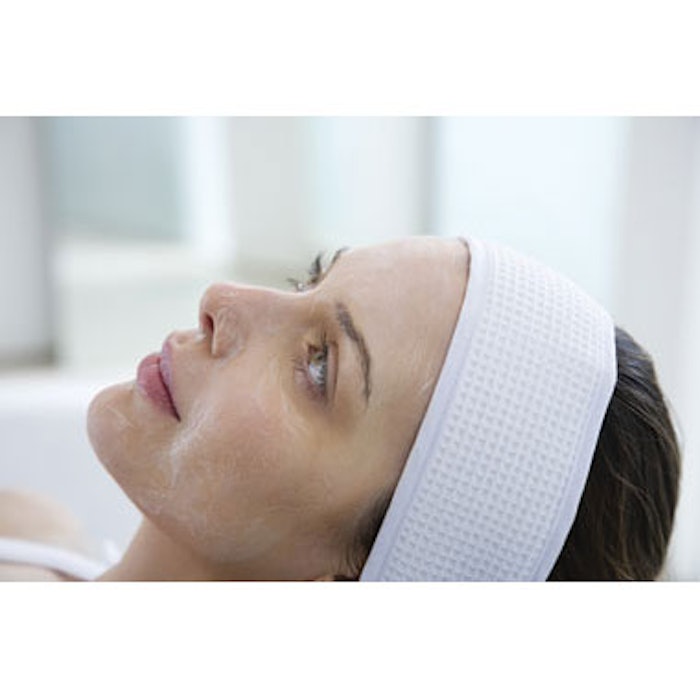
Few treatment modalities have the ability to treat as wide a variety of patients and concerns as chemical peels. Whether an individual wants to reduce fine lines and wrinkles, get rid of facial scarring or knock down cystic acne, there is a peeling agent that can help.
The first peel widely used in cosmetic medicine was the Baker-Gordon peel—a combination of croton oil, phenol and septisol soap. “The challenge with phenol peels is you have to be connected to an EKG, because you can have heart flutter,” says Robert Manzo, founder of Skinprint, a developer of physician-dispensed skincare products and medical-grade chemical peels. Though deep phenol and croton oil peels are still performed today, they have largely been replaced by fractional resurfacing lasers and safer peeling agents.
“The most popular ingredients for chemical peels today include alpha-hydroxy (AHA) and beta-hydroxy acids (BHA), trichloroacetic acid and retinol,” says Rhonda Allison, founder and CEO of Rhonda Allison Cosmeceuticals.
“Glycolic is the smallest of the range of AHAs, and it is the most effective,” says Manzo. “Glycolic peels typically come in 10%, 30% and 70%. In most states that regulate peels, 20% is the cutoff where estheticians can do them without supervision by a physician. So many companies make a 20% solution of glycolic for estheticians as well.”
The difference between today’s high percentage glycolic peels and earlier phenol and croton oil peels is that glycolic acid offers simple tissue removal while “the skin rebuilds itself in a slightly different way after a phenol peel,” says Manzo. “With a 70% medium-depth glycolic peel you do get nice tissue removal, but nothing compared to the old croton oil and phenol peels. What you’re doing with glycolic peels is you’re just removing tissue. You’re not activating the skin at all, though you can make the argument that you’re getting new collagen and elastin production because your skin sees the injury, but it’s minimal.”
Trichloroacetic acid (TCA) is another popular agent for medium-depth peels. But due to its poor penetration, it is typically combined with AHAs, as in the Jessner Peel. “TCA is rarely used alone as an acid. You usually have TCA with glycolic or TCA with phenol, because on its own you won’t get that full peeling effect; it doesn’t go as deep,” says Manzo. “When you put it with AHAs, that combination brings it deeper into the skin.” He notes that one of the benefits of TCA is that, similar to phenol, it not only peels but also modulates the skin to behave differently. “So you get a longer-lasting benefit for tone and texture,” he says.
Peeling Away Hyperpigmentation
Most chemical peels offer some benefit for patients with melasma and hyperpigmentation by virtue of their exfoliating action, which stimulates new cellular growth. Manufacturers are boosting these results by adding skin lightening ingredients, such as hydroquinone, azelaic acid and kojic acid to their formulations to create specific skin-brightening peels.
“The problem with kojic acid—an analog of arbutin—is that it autodegrades when water is present in your formulation,” says Manzo. “It starts to turn brown and goes away. So it has to be in an anhydrous vehicle to remain stable and be effective.”
Though chemical peels are an effective treatment for pigmentation problems, more aggressive peels also carry the risk of causing post-inflammatory hyperpigmentation (PIH). The risk increases in patients with darker skin types. They key to preventing PIH lies in post-peel care.
Image copyright Image Source/Getty Images
[pagebreak]
“In general, the more pigment in the skin, the higher the risk of PIH,” says Manzo. “Typically patients with a high Fitzpatrick skin type—high III, IV, V or VI—are warned off these peels with informed consent. But if you understand skin chemistry, you can do a pretty good job at preventing PIH.”
The goal, he says, is to “reduce inflammation, reduce inflammation, reduce inflammation. The way you do that is through postprocedure anti-inflammatory topicals. If you want to perform an aggressive chemical peel on darker skin, you should always have 1% hydrocortisone in the post-care product to reduce the edema as well as the inflammation.”
Manzo also recommends having these patients come back for a follow-up exam five to seven days after treatment. “You have literally 7 to 10 days to address PIH,” he says. “Once you see the PIH bloom and you’ve gone past the 10 days, you have a problem, because it’s going to be three or four months before you can remediate that. We always train people in our industry to have the patient back within five to seven days for an examination to see if PIH is starting to come up, so you can mitigate it.”
Pre- and Post-Peel Care
Though the risks of hyperpigmentation are greatest in patients with darker skin types and with the use of more aggressive peels, even patients undergoing superficial AHA and BHA-based treatments will see better and longer improvement when treatment incorporates pre- and post-care products.
“The extent to which you can control what a patient uses after a peel will determine the outcome of the peel,” says John Kulesza, CEO of Young Pharmaceuticals. “If patients go home and put any product they want on their faces, they can have a bad reaction. The peel removes the top layers of skin, so allergy-causing ingredients can penetrate and do more damage. Then the patient will go back to the doctor and say, ‘You did this to me!’”
He recommends providing patients with sensitive skin products, such as sunscreens, moisturizers and cleansers, to use for the first few days after the procedure to optimize results. Most peel manufacturers now offer post-peel kits to practices that carry their lines. Young Pharmaceuticals offers a special cleanser that is sodium laurel sulfate- and propylene glycol-free, “because these are irritants,” says Kulesza. “We give them a special fragrance-free cleanser and sunscreen and a special moisturizer that is formulated for very sensitive skin.”
Rhonda Allison has developed two different post-care kits specifically designed for use after a peel: one kit for superficial peels and another for mid- to deep-level peels. These products contain ingredients such as arnica and hydrocortisone to sooth the skin and relieve itching, as well as epidermal growth factors to support cell renewal and wound repair.
NIA24 has developed what it calls an “enhancement system” for use after in-office peels, which includes a gentle cleanser; a skin-strengthening complex to help heal the skin after the peel; a rapid exfoliating serum to help maintain results; and a mineral (zinc oxide and titanium dioxide) sunscreen with SPF 30.
“For any superficial peel—and that’s defined as peels that aren’t removing more than 5µ of tissue—you can put sensitive skin cleanser and lotions first for post-care because you’re only going to be red and slightly edemic for a day,” says Manzo. “Once you start to get into medium and deep peels, you should always have a significant set of anti-inflammatory products, including a sensitive skin cleanser, a serum to reduce inflammation and a lotion with 1% hydrocortisone. This will prevent most PIH reactions and will also prevent the histamine response, which gives rise to itching and burning.”
Image copyright Image Source/Getty Images
[pagebreak]
Selling homecare kits makes good business sense, too, says Kulesza. If a patient is given a product and they start to really like it, they will return to purchase it from the practice.
Properly preparing the skin for peeling is also critical to achieving good outcomes. “The whole idea is to make the peel bio-available, so you need to wash and you need exfoliate,” says Manzo. “Some people microderm, some people dermaplane, some people do an acetone wash—the whole point is to intentionally break the barrier, so that the peel gets to the intended target in the skin.” For best results, providers should follow the instructions provided by the manufacturer of the peel.
NIA24 has gone beyond basic skin prep with its new Cellular Resurfacing Peel, a two-step program that includes a treatment to prepare skin for peeling and an antioxidant-rich, multi-acid chemical peel for skin rejuvenation. The pre-peel regimen includes the company’s proprietary Pro-Niacin complex, which delivers vitamin B3 deep into the epidermis via a lipophilic tail to improve moisture retention, support the skin’s barrier function, and increase cell turnover and photo-protection. Additional ingredient Saccharomyces lysate, or yeast extract, helps to boost the skin’s oxygen content and neutralize the effects of environmental damage.
The peel itself contains glycolic, lactic and fruit acids, as well as willow bark extract, and extract of bilberry, sugar maple, orange and lemon. The company chose these ingredients, says Shawn Morgan, vice president of NIA24 at Strivectin Operating Company, because they combine to unclog pores, stimulate collagen production, accelerate cell renewal and turnover, and even out skin tone, while hydrating skin and reducing inflammation.
When a Peel Is Not a Peel
One of the more recent innovations in aesthetic peels is the use of acids that don’t actually peel the skin. Rhonda Allison has created what it calls “couture peels” using flower acids, such as hibiscus, which has lightening properties, and anthocyans—powerful antioxidants that fight aging by capturing free radicals and reducing oxidative stress.
The ingredients derived from the hibiscus chalice are high in pyruvic acid (5%) and citric acid (10%). “These acids can be thought of as second generation AHAs because they increase the rate of cellular turnover and do not irritate the skin,” says Allison. “They also stimulate collagen production.”
Hydrating lactic acid peels are “a bit of a misnomer,” says Manzo. “Because there’s really no ‘peel.’” Instead, lactic acid binds moisture into the lipid layer of the stratum corneum to block transepidermal water loss. “Through that mechanism of action, it moisturizes, hydrates and smooths skin. It’s a very deep, hydrating treatment,” he says.
Skinprint also offers an l-ascorbic acid peel for people exposed to a high level of sunlight or environmental pollution. “These peels are extremely effective for people who see a lot of sun because vitamin C is a very good free radical quencher,” says Manzo. “For people who are in environmental situations where there is a lot of smoke or pollution, or those who are in the sun quite a bit, these peels—which are not actually peels, they’re treatments—are very effective at prevention and correction of oxidation in the skin.”
When investigating peel products, it is important to understand not only the percentage of acid in the peel, but also the pH. Many companies, but not all, use buffering agents in their peels. The alkaline agents increase the pH level. “If I put a 70% solution of glycolic in a beaker, the pH of that solution is going to be a little bit over 1—1 to 1.2—and that is a very aggressive peel,” says Manzo. “What a lot of manufacturers do is they buffer it and bring that peel up to 2.5 or 3. Because the buffered peel has a higher pH, there is only 50% glycolic acid available. That’s why doctors and estheticians see differences between these different peels. They’re the same percentage, but some are buffered. The bottom line is, know your pH, because that gives you a good knowledge base to determine the peel’s efficacy and depth.”
Charlotte LoBuono is a freelance writer based in Hoboken, NJ.
Image copyright Image Source/Getty Images











